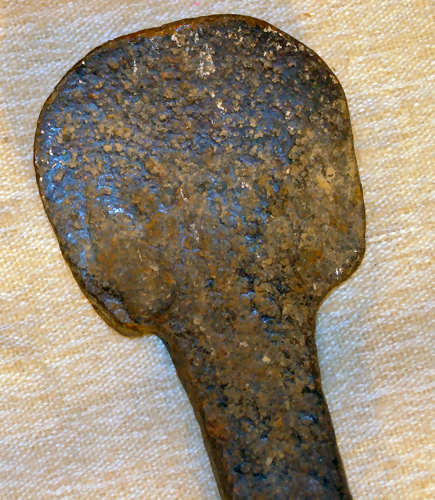

![]() I'm sure that everyone reading this post is familiar with the spud and the purpose for which it was used.
I'm sure that everyone reading this post is familiar with the spud and the purpose for which it was used.

![]() Now I'm sure that everyone reading this post, after seeing the two photos, knows for certain what the spud was used for. But in case you still don't know how this tool was used, even after seeing photos of it, I'll explain...
Now I'm sure that everyone reading this post, after seeing the two photos, knows for certain what the spud was used for. But in case you still don't know how this tool was used, even after seeing photos of it, I'll explain...
![]() The spud was an essential tool used by woodsmen. It was used to separate the bark from a tree.
The spud was an essential tool used by woodsmen. It was used to separate the bark from a tree.

![]() After a tree would be felled, and the branches cut from the trunk, all would be cut into segments. Each segment, in turn, would be secured in some way, such as by hammering one leg of a "U" shaped 'log-dog' into the log and the other into a stationary 'log stand'.
After a tree would be felled, and the branches cut from the trunk, all would be cut into segments. Each segment, in turn, would be secured in some way, such as by hammering one leg of a "U" shaped 'log-dog' into the log and the other into a stationary 'log stand'.
![]() The woodsman would hold the metal 'neck' of the spud in one hand and the wooden 'handle' in the other. The fore-edge of the flattened head of the spud would be rammed against the bark of each segment, parallel to the length of the segment, and with the bevel edge facing away from the worker, in order to break the surface of the bark. When a break or crack in the outer bark would be effected, the flattened head of the spud would be turned around so that the bevel edge would be facing the worker; the spud would be forced farther into the crack and then jostled back and forth to increase the space between the bark and the sapwood. The tool would be moved in a line lengthwise along the log segment, cracking the outer bark, and continuing to loosen it from the log until the entire length of the log would be accomplished.
The woodsman would hold the metal 'neck' of the spud in one hand and the wooden 'handle' in the other. The fore-edge of the flattened head of the spud would be rammed against the bark of each segment, parallel to the length of the segment, and with the bevel edge facing away from the worker, in order to break the surface of the bark. When a break or crack in the outer bark would be effected, the flattened head of the spud would be turned around so that the bevel edge would be facing the worker; the spud would be forced farther into the crack and then jostled back and forth to increase the space between the bark and the sapwood. The tool would be moved in a line lengthwise along the log segment, cracking the outer bark, and continuing to loosen it from the log until the entire length of the log would be accomplished.
![]() here are two layers of bark on a tree: the outer bark and the phloem or inner bark. Sometimes the inner bark was needed to be preserved for use. The trick was to separate the outer layer without damaging the inner layer in the process. The woodsman, through practice, would come to know how much pressure to apply so that he would not penetrate too far with each jab of the spud.
here are two layers of bark on a tree: the outer bark and the phloem or inner bark. Sometimes the inner bark was needed to be preserved for use. The trick was to separate the outer layer without damaging the inner layer in the process. The woodsman, through practice, would come to know how much pressure to apply so that he would not penetrate too far with each jab of the spud.
![]() The inner layer of bark would be carefully removed from the log segment and utilized to make cordage (which was used for basket making, chair matting and so forth). This more delicate work was accomplished by chisels rather than the spud.
The inner layer of bark would be carefully removed from the log segment and utilized to make cordage (which was used for basket making, chair matting and so forth). This more delicate work was accomplished by chisels rather than the spud.
![]() The spud shown above in the photos was fabricated by a blacksmith in iron in the process known as wrought iron. Despite being between 100 and 150 years old, the iron does not display any rust. The pitted look of the surface is the result of the iron having been hammered into shape by the blacksmith.
The spud shown above in the photos was fabricated by a blacksmith in iron in the process known as wrought iron. Despite being between 100 and 150 years old, the iron does not display any rust. The pitted look of the surface is the result of the iron having been hammered into shape by the blacksmith.

